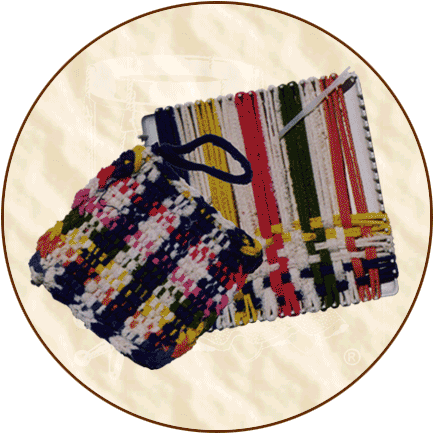.
Continued from product description
on Home Crafts' Page Five...
Historical
Background: The potholder loom was conceived in the 1930s
as a means to use "loopers" in a creative way. Loopers,
also known as "cut off strips," are a waste product
of the hosiery industry. Hosiery and sock mills had vast amounts
of waste from a piece of the sock tubing that was cut off. Hosiery
was made on a Looper Machine, which works much slower than the
"sewing clip" used today to make cut off strips or
loopers. This is where we get the names "looper loom"
and "loopers."
The looper loom (or potholder loom) has been a popular item
since its introduction. Manufacturers have supplied metal, plastic,
"bakelite," and wood looms that are between seven and
eight inches square. The names of some of the older loom packages
were Hi-Ho Colonial Looper Loom, Davis Adjustable Loom, Child's
Looper Loom by Lily, Avalon Weaving Loom, Jiffy Loom, Weave-It
Hand Loom by Donar Products, Stephen's Looper Loom, Happy Folks
Weaving Loom by Pyramid Mills Co., Weaving Loom by Lisbeth Whiting,
Handicraft Weaving Loom, and Hand Weaving Loom by WNC.
Some manufacturers also utilized yarn for these looms and
included needles. Donar Products made a small two-inch square
loom to use with yarn. A long metal or plastic hook is included
with most Looper Loom packages to assist with the weaving of
the loopers, but fingers can also be used. The Davis Adjustable
Loom was metal with three extra slots on opposite sides for varying
the size of rectangular weavings.
Historical Folk Toys is pleased to offer this product to today's
children. Many schools and art teachers use this loom to teach
their students basic weaving principles. Happy weaving!













